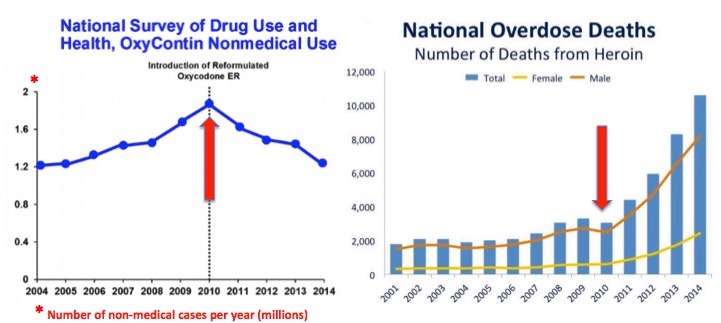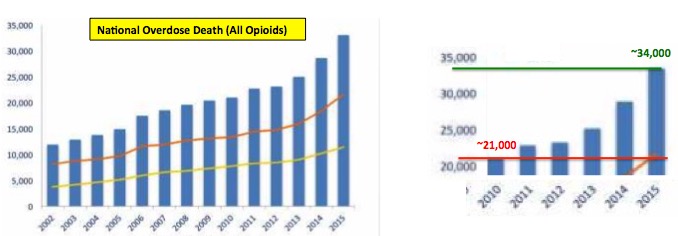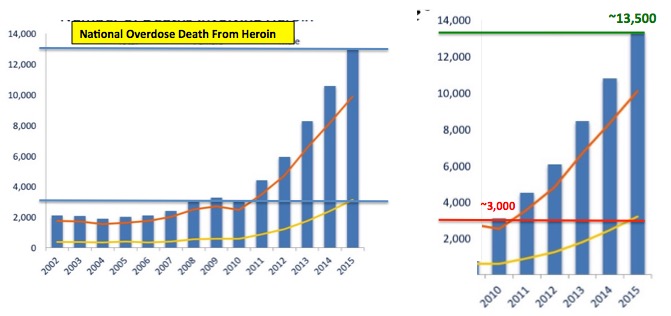I hate to say "I told you so." It's really obnoxious. But in this case, I'll make an exception.
"I told you so."
Dedicated to the Kolodnys and Juurlinks of the world who can't see past their own biases
It took one study, three authors, 17,701 words, 50 pages, and 70 references to conclude something that has been blatantly obvious for quite some time:
"The reformulation [of OxyContin] did not generate a reduction in combined heroin and opioid mortality—each prevented opioid death was replaced with a heroin death."
Walter N. Evans, et. al., "How the Reformulation of OxyContin Ignited the Heroin Epidemic" February 2018
Figure 1, which I first cobbled together in 2016, tells the same story, and reaches the same conclusion (1) but it didn't require three authors, 17,701 words, 50 pages, or 70 references.

Figure 1. The impact of abuse-resistant OxyContin on heroin overdose deaths. Beyond obvious.
And while the quote above would seem to validate what I've written, as well as the consensus of the pain community, I maintain that it doesn't go nearly far enough to give the whole picture. While it is true that people who have died from an overdose, whether from OxyContin or heroin, are equally dead, this statement implies that it was a zero-sum game. It was not. Keep reading.
The quote is confusing and misleading. In fact, the withdrawal of the "original" OxyContin from the market did not result in a simple 1-for-1 substitution of deaths. There were far more deaths after 2010. But it wasn't from pills. Deaths from pills were essentially unchanged from 2010-15 (Figure 2). There is no real difference from 2010 than in 2015 despite the removal of abusable OxyContin - the driving force behind today's addictions.

Figure 2. Deaths from prescription opioids by year (2010-2015). The graph on the right is a magnification of the key data from the full graph on the left. Source: Adapted from NIH
Hmm. It would seem that the introduction of abuse-resistant OxyContin had virtually no impact on pill deaths during the same time interval. But what about total opioid deaths? Is this a zero-sum game? Hardly. Figure 3, which gives the total deaths from all opioids, both legal and illegal, makes this very clear. Far more people died from opioid overdoses after abuse-resistant OxyContin was introduced in 2010.

Figure 3. Deaths from all opioids by year (2010-2015). The graph on the right is a magnification of the key data from the full graph on the left. Source: Adapted from NIH
How strange. Original OxyContin is gone, abuse-resistant OxyContin use is far lower, yet the number of deaths from all opioids has increased by about 13,000. What could possibly be responsible for this?? Perhaps another drug, let's say, heroin? It would seem so (Figure 4).

Figure 4. Deaths from heroin by year (2010-2015) Source: Adapted from NIH
Things should be quite obvious at this point. Fewer abusable OxyCodone pills in circulation had no impact on deaths from prescription opioids between 2010-15. But during that same time, deaths from all opioids increased by about 13,000. It is no coincidence that deaths from heroin rose by about than 10,500. This was entirely predictable. Heroin and/or fentanyl were and still are the primary drivers of opioid overdoses. They have always been.
So, no - in the years following the introduction of abuse-resistant OxyContin each prevented opioid death was not replaced with a heroin death. But rather, there were 10,000 extra heroin deaths.
Lessons unlearned:
- When addicts no longer had access to the huge dose (2) of oxycodone that was contained in the "old" OxyContin, they found something else.
- The "something else" was Vicodin, Percocet, and heroin.
- When Vicodin and Percocet pills became too expensive or hard to get because of legal restrictions, addicts switched to heroin.
- Keep #3 in mind.
- The soaring death toll was caused by the shortage of pills, not an excess of them. I don't know whether this was accidental or intentional or both (3).
More (and worse) unlearned lessons:
- History repeated itself (and then some) when CDC "guidelines" (4) resulted in severe restrictions on the availability of opioid pain medications. The "guidelines" have turned into laws that are resulting in forced tapering, the closing of pain clinics, physicians getting out of pain management en masse, and persecution of the few brave physicians who had the unmitigated gall to give their patients the drugs they needed.
- Now, because of dreadful federal and state policies, there is a cruel added burden for pain patients who use, not abuse the drugs, to get the medicines they need.
- Pain patients are terrified, and rightfully so.
- Some are committing suicide rather than face untreated pain; these numbers are growing.
- Some are going to the street to buy heroin to control their pain.
- (This one is REALLY terrible) There are now fentanyl test kits so that people, both addicts, and undertreated pain patients who have been forced to turn to heroin, can tell if there is fentanyl in the heroin.
- The number of prescriptions continues to drop while at the same time the total opioid overdose deaths keep soaring.
- If you can find a worse example of the consequences of horrible government policy than #7 please let me know.
- Good luck with that.
American Council's Dr. Chuck Dinerstein has his own take on the matter:
The progression from pharmaceuticals like OxyContin to heroin is called substitution. Conceptually and economically it is no different than raising the taxes on soda and being surprised that people are now drinking more juice. Worse still, illicit drugs are by their nature untrustworthy. Can you expect your drug dealer to use the same quality controls as pharmaceutical companies? Of course not. So it is no surprise that in the absence of trust, people who need but cannot obtain pain relief are forced to test what they buy on the black market. This is an abomination.
Dr. Chuck Dinerstein, Medical Fellow, American Council on Science and Health
Thanks to the CDC, its minions at PROP (5), and the Gestapo Enforcement Agency we now have two disasters on our hands; more addicts dying and pain patients suffering unnecessarily. Could our opioid policies possibly be worse?
I can't imagine how, but given what I've seen so far, yes, I think things could get worse. Let's not underestimate the power of our government to screw things up.
I'm a former organic chemist, not a trained investigative journalist, yet all I had to do was create a simple graphic which made it so obvious what was going to happen next. And it did. It had to.
This atrocious chapter in American history is still being written. I wish I could be as sure about the end of the chapter as I was about the beginning. Or perhaps I just don't want to know.
NOTES:
(1) At the American Council, we are constantly debunking ridiculous studies that find a coincidental relationship between two events, and conclude that one caused the other. The expression "correlation does not equal causation" could easily be our motto. But just because most of these studies are nonsense, this doesn't mean that correlation does not equal causation. Sometimes it does. This is clearly one of those times. Addicts did not get together and decide to switch to heroin which then drove down the sales of OxyContin.
(2) At one time a high-dose OxyContin pill contained 80 mg of pure oxycodone, the equivalent to 16 Percocet pills. This is a huge dose, more than enough to turn someone who was experimenting with the drug into an addict.
(3) A prevailing opinion within the pain community is that the driving force behind the unprecedented government involvement in the physician-patient relationship was a serious conflict of interest. I will not comment on this. But Pat Anson, the editor of Pain News Network certainly did.
(4) Guidelines, my ass.
(5) PROP is the acronym for Physicians for Responsible Opioid Prescribing. The group was instrumental in formulating the CDC "advice." I don't trust them one bit.




